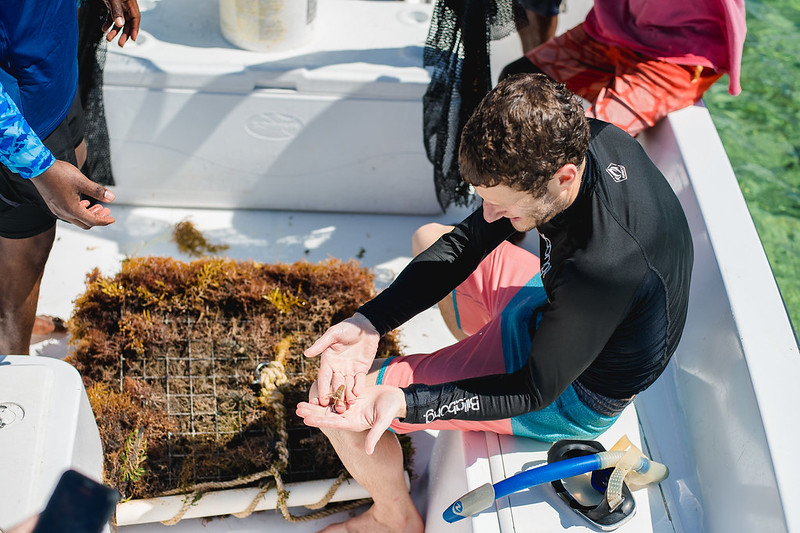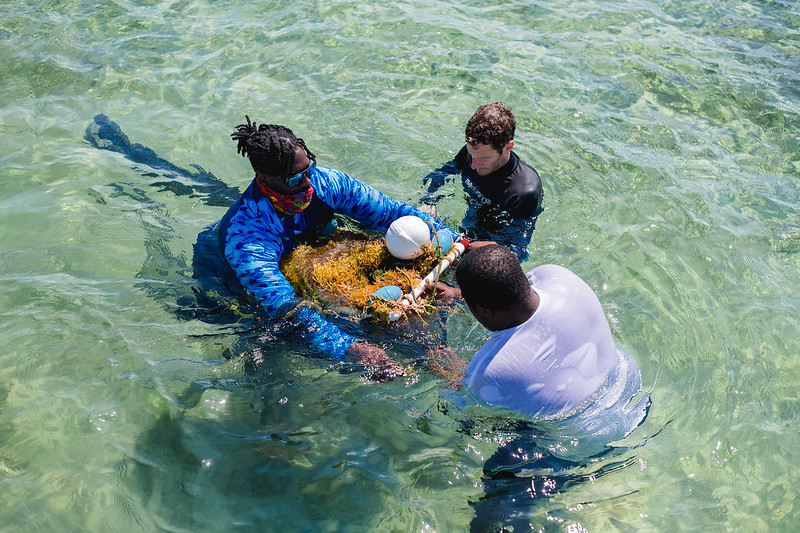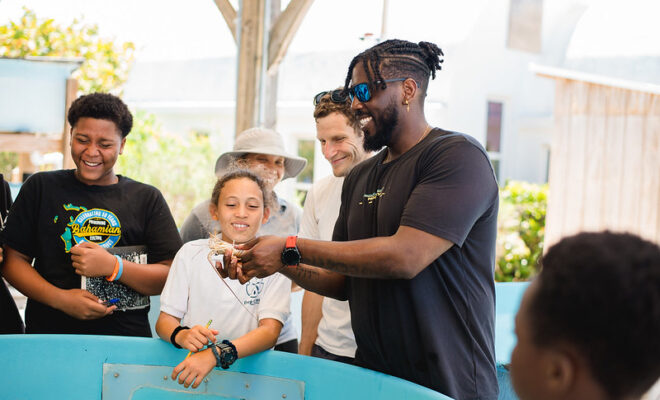Scientists from The Island School’s Cape Eleuthera Institute are working to set up a new nursery facility for growing crawfish in South Eleuthera, and they want members of the community to get involved. If this sparks your interest then read on. While the crawfish fishery in The Bahamas is relatively healthy right now, the species continues to be heavily fished and stocks may not be able to support further growth in the fishery. Crawfish aquaculture can both protect the species and open up new ways of diversifying the ‘blue economy’.
How do you raise crawfish in an aquaculture environment?
Our Crawfish Aquaculture process begins with collecting the baby crawfish (the seed stock) when they first settle to the seabed after spending months drifting around in the open ocean currents. These little lobsters are only as long as the first joint of your pinky finger. They like to live on seaweeds for protection in the early stages of their lives, and this is the secret to collecting them. The collector devices, made by the research team, are covered in fibers that mimic the seaweeds, so the baby crawfish settle on them for shelter. They can then be easily harvested from the collectors.
From here, the baby crawfish are taken back to the aquarium facilities at the Cape Eleuthera Institute to grow up in protected conditions. Researchers are currently experimenting with different grow-out setups, including sea cages designed by partners from the UK’s National Lobster Hatchery. The grow-out, crawfish cultivation setups are being studied by CEI Visiting Scientist Michael Bowleg, a Bahamian PhD student working on the project with the University of Exeter. Once the crawfish reach the juvenile stage at about 5 inches in length, they can either be released to restock fishing grounds or kept on for continued grow-out for the aquaculture industry.
“The vision is that, once established, we can scale this model and take the community with us. We want to engage craft workers to make the equipment for us from locally sourced materials and work with fishers, putting out the collectors and selling the baby crawfish back to us”, says CEI Director of Research and Innovation Dr. Nick Higgs, who is also a native of Spanish Wells, the home of crawfish fishing in The Bahamas. The big question is whether this can be sustainable, both environmentally and economically.

Is it OK to collect baby crawfish?
On the environmental side, people might be concerned about taking baby crawfish from the wild for seed stock. The key is taking them to the earliest stage of life when they are an inch or less long and very abundant. Being so small, the baby crawfish are very likely to be eaten by bigger animals. In fact, scientists think that over 97% of these baby lobsters don’t survive into adulthood. Since so many of these baby lobsters die in the wild at this early stage, taking a few hundred will not have an impact on recruitment to the wild stocks. Instead, they are taken to grow up in the safety of the crawfish nursery.
This is very different from taking an undersized juvenile crawfish, which is illegal. Once a crawfish reaches about 3 inches long the survival rate goes up dramatically and that crawfish has a good chance of surviving to join the reproductive population. So these should be left to grow and reproduce. “We are essentially taking the ones that would have died in the wild anyway”, says Dr. Higgs, “so it is not the same as taking a larger crawfish that might go on to adulthood”.

Is this model economical?
Dr. Higgs is optimistic that this can be done economically too. In contrast to big predator fish like tuna and salmon that need a high protein diet, crawfish feed lower down in the food chain and have a varied diet. This means that it should be easier to feed them, which has been a big barrier to most aquaculture operations. The project will also be replicated with partners at the Bahamas Agriculture and Marine Science Institute (BAMSI) in Andros to see how similar supply chains can be established across the Bahamian islands.
If you are interested in working with the Cape Eleuthera Institute, please get in touch by emailing research@islandschool.org or you can WhatsApp 242 823-8393, with your name and contact details. We are looking to work with someone to build the collectors for us, ideally with experience in weaving, and particularly experience with sisal work. We are also interested in training people to use the collectors and buying baby lobsters from them.
